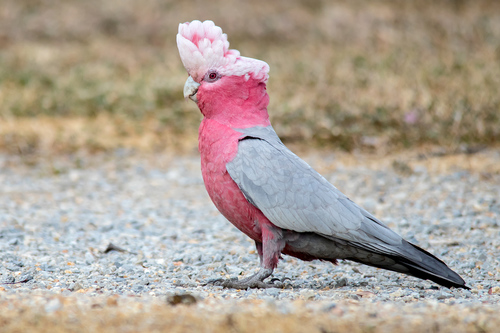
Galah
The Galah (*Eolophus roseicapilla*), also known as the Rose-breasted Cockatoo, is a highly recognizable and widespread parrot native to Australia. Known for their vibrant pink and grey plumage, Galahs are highly social birds, often seen in large, noisy flocks. They play a significant role in the Australian ecosystem as seed dispersers and are a common sight in both rural and urban environments. Culturally, they are a familiar and beloved bird across Australia, often featured in art and folklore, and are sometimes kept as pets, although this requires specialized care.
34-38 cm
Length
70-80 cm
Wingspan
Least Concern
Conservation Status
Distribution
Endemic to Australia, Galahs are found throughout the mainland and have been introduced to Tasmania. They are absent only from the most arid deserts and the densest rainforests of Cape York Peninsula.
Lifespan
Up to 40 years in the wild, and up to 70-80 years in captivity with proper care.
Galah's Habitat
Habitat Types
Open grasslands, Savannas, Woodlands, Agricultural areas, Urban parks and gardens
Climate Zones
Temperate, Subtropical, Tropical, Arid
Adaptations
Galahs are highly adaptable to a range of habitats. Their ability to utilize human-modified landscapes, such as farmland and urban areas, has contributed to their widespread success. They have strong beaks for cracking seeds and nuts, and their flocking behavior provides protection from predators.
Variations
Three subspecies are generally recognized: *E. r. roseicapilla* (Western Australia), *E. r. albiceps* (Eastern Australia), and *E. r. kuhli* (Northern Australia). These subspecies differ slightly in plumage color and size.
Appearance
Breeding Plumage
No significant difference between breeding and non-breeding plumage.
Seasonal Feather Changes
Minimal seasonal variation.
Sex Based Plumage Differences
Males and females have very similar plumage. Subtle differences may be observed in the color of the iris, with males typically having darker brown irises and females having a more reddish-brown iris.
Notable Features
Bright pink chest, belly, and lower face., Pale grey back and wings., Pale pink crest, which can be raised or lowered., Greyish-white bare skin around the eyes (eye-ring).
Diet and Feeding
Primary Foods
Seeds, Grains, Fruits, Nuts, Roots, Insects and their larvae (occasionally)
Foraging Behavior
Galahs primarily forage on the ground, often in large flocks. They use their strong beaks to crack open seeds and nuts. They also dig for roots and tubers using their beaks and feet.
Specializations
Their strong beak is well-suited for cracking hard seeds. They also have a zygodactyl foot arrangement (two toes pointing forward and two backward), which provides a strong grip for climbing and manipulating food.
Seasonal Diet Variations
Their diet varies seasonally depending on the availability of food. In agricultural areas, they may feed on cultivated crops such as wheat and sunflower seeds.
Behavior
Social Structure
Highly social birds, often found in large flocks that can number in the hundreds or even thousands. Within these flocks, pairs often remain bonded for life.
Communication
Loud, screeching calls, Contact calls to maintain flock cohesion, Alarm calls to warn of danger, Crest raising and lowering to communicate mood
Migration
Generally non-migratory, but may undertake local movements in response to food availability.
Territorial or Group Behaviors
While generally not highly territorial outside of the breeding season, they will defend their nest hollows vigorously. Flocks exhibit cooperative behaviors, such as communal roosting and coordinated foraging.
Conservation
Threats
Habitat loss due to land clearing for agriculture and urbanization, Competition for nest hollows with other species (including introduced species like the European Starling), Persecution as agricultural pests in some areas, Illegal trapping for the pet trade (although less common now due to regulations)
Protection Programs
Protected under Australian law (Wildlife Conservation Act), Habitat restoration and revegetation programs in some areas, Monitoring of populations
Local National Laws
Protected under the Wildlife Conservation Act in Australia. Permits are required for keeping or trading Galahs.
Population Trend
Stable
Population Estimates
Although precise numbers are difficult to obtain, the Galah population is considered large and widespread.
Interesting Facts
Galahs are known for their playful behavior.
They are often observed engaging in acrobatic displays, hanging upside down, and playing with objects.
The name "Galah" comes from an Aboriginal language.
The word 'gilaa' comes from the Yuwaalaraay and neighboring Aboriginal languages of northern New South Wales, Australia.
Galahs can form hybrid offspring with other cockatoo species.
Hybrids with species such as the Sulphur-crested Cockatoo and the Little Corella have been recorded.
They are one of the most successful and abundant cockatoo species in Australia.
Their ability to adapt to a wide range of habitats, including human-modified landscapes, has contributed to their widespread success.
Faqs about Galah
Can Galahs talk?
Yes, Galahs are capable of mimicking human speech, although their vocabulary may be limited compared to some other parrot species. Their talking ability varies between individuals.
Are Galahs good pets?
Galahs can be affectionate and entertaining pets, but they require a significant commitment. They are intelligent and social birds that need a lot of attention, interaction, and a spacious enclosure. They can also be very loud and destructive if their needs are not met. Potential owners should research their needs thoroughly and be prepared for a long-term commitment. Consult a professional for expert advice.
What do I do if I find an injured Galah?
If you find an injured Galah, contact a local wildlife rescue organization or veterinarian. Do not attempt to handle the bird unless you have experience, as they can bite. Provide a safe, quiet, and dark environment for the bird while waiting for assistance.
Copyright @ Nature Style Limited. All Rights Reserved.
 English
English